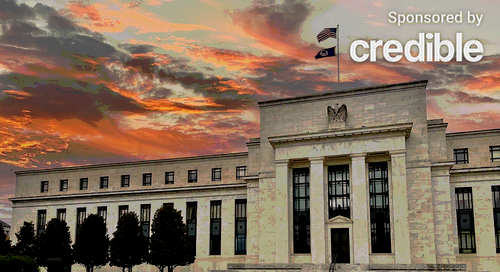
The Fed delivered another highly anticipated pause on interest rate hike, but the future is still uncertain, economists say. (iStock)
The Federal Reserve announced another pause on interest rate hikes during its November meeting on Wednesday, leaving the federal funds rate at a 22-year high of 5.25% to 5.5%.
In a statement, the central bank reaffirmed its commitment to bring inflation to a 2% target rate, and it would continue to assess economic indicators to determine if additional rate hikes are warranted. The Fed cited moderating but still strong employment figures, the low unemployment rate, and still too-high inflation as recent indicators that suggest that economic activity expanded at a robust pace in the third quarter of this year.
Despite the pause, the Fed may not yet be done with interest rate hikes, according to CoreLogic Chief Economist Selma Hepp. The progress on slowing inflation has been solid, but monthly readings still trended higher in August and September. Job growth has also proven resilient and, in September, rose by 336,000 and the unemployment rate held steady at 3.8%.
Meanwhile, gross domestic product (GDP) in the third quarter of 2023 increased at more than twice the rate of growth in the previous quarter despite the Fed’s efforts to slow the economy and lower soaring inflation. This leaves the option for an additional future rate hike on the table.
“The Fed’s decision to hold interest rates steady comes as no surprise, though they continue to remain very cautious and keep their options open for additional tightening,” Hepp said. “The central bank is exercising caution while waiting for the jobs report on Friday to see if the economy is finally showing signs of softening. Although the recent GDP reading was exceptionally strong, inflation has continued to drift towards the 2% FOMC target. But, bumps in the road remain as most recent wage growth data suggests that labor cost pressures persist while elevated energy prices may seep into other components of inflation going forward.”
If you’re worried about the state of the economy, you could consider paying down high-interest debt with a personal loan at a lower interest rate. Visit Credible to speak with a personal loan expert and get your questions answered.
BUY A HOME IN THESE STATES TO GET STUDENT LOAN DEBT RELIEF
Popular 30-year mortgage rate nears 8%
The pause on interest rate increases has yet to have the effect of lowering mortgage rates. That’s because the 30-year, fixed mortgage rate is also loosely benchmarked on the 10-year Treasury yield, which has risen a whole percentage point since the beginning of the third quarter, even though the Fed raised the Fed Funds rate just once in this period following its July meeting, according to Realtor.com Chief Economist Danielle Hale.
“With longer-term rates climbing higher, mortgage rates have followed suit,” Hale said. “The widely watched Freddie Mac mortgage rate index hovers just below 8%, a threshold some other mortgage rate trackers have already exceeded. The 23-year high in mortgage rates follows all-time lows reached just three years ago and highlights the effect that financing costs have on the housing market–a particularly rate-sensitive sector of the economy.”
Mortgage borrowers have to shell out an extra $256 or 12.4% more to finance a house in the current market environment compared to a year ago and more than $1,170 from September 2020, according to Realtor.com.
There may be some relief in mortgage rates if inflation continues to moderate and the labor market shows signs of cooling, First American Deputy Chief Economist Odeta Kushi said.
“Looking ahead, if incoming labor market and inflation data surprise to the upside and prompt more aggressive contractionary monetary policy from the Fed than expected, mortgage rates could increase further,” Kushi said. “However, if inflation continues to head towards the Fed’s 2% target, the labor market is cooling, and the Fed hits ‘pause’ on rate hikes, treasury yields may retreat, providing buyers some reprieve from rising mortgage rates.”
If you’re looking to become a homeowner, you could still find the best mortgage rates by shopping around. Visit Credible to compare your options without affecting your credit score.
MANY AMERICANS PREPARING FOR A RECESSION DESPITE SIGNS THAT SAY OTHERWISE: SURVEY
What the Fed’s decision means for your wallet
The Fed’s pause on interest rate increases should mitigate the likelihood of additional increases in credit card interest rates. That’s good news for credit card holders who carry a balance and may be using those credit lines to manage their monthly finances in this environment of higher prices, according to Charlie Wise, the senior vice president of research and consulting at TransUnion.
Interest rates on credit cards have reached historic highs, mainly in response to an aggressive campaign of rate hikes by the Federal Reserve in 2022 and 2023. The average interest rate on a new credit card offer is up to 22.78%, according to WalletHub and the average consumer carries roughly $6000 balance.
“At a time when many consumers are already making adjustments to their household budgets with the resumption of student loan payments, the fact that the Fed is holding steady for now may at least begin to impart positive impacts to the credit markets,” Wise said. “For instance, while the mortgage market will likely continue to be significantly less active than typical, some potential homebuyers who had been waiting for rate stability may enter, or at least consider entering, into the homebuying process.”
If you’re concerned about high-interest debt, you could consider paying it off with a personal loan at a lower interest rate, which could cut your monthly payments. Visit Credible to get your personalized rate in minutes.
COLLEGE TUITION PAYMENT PLANS MAY PUT STUDENT AT RISK: CFPB
Have a finance-related question, but don’t know who to ask? Email The Credible Money Expert at moneyexpert@credible.com and your question might be answered by Credible in our Money Expert column.



